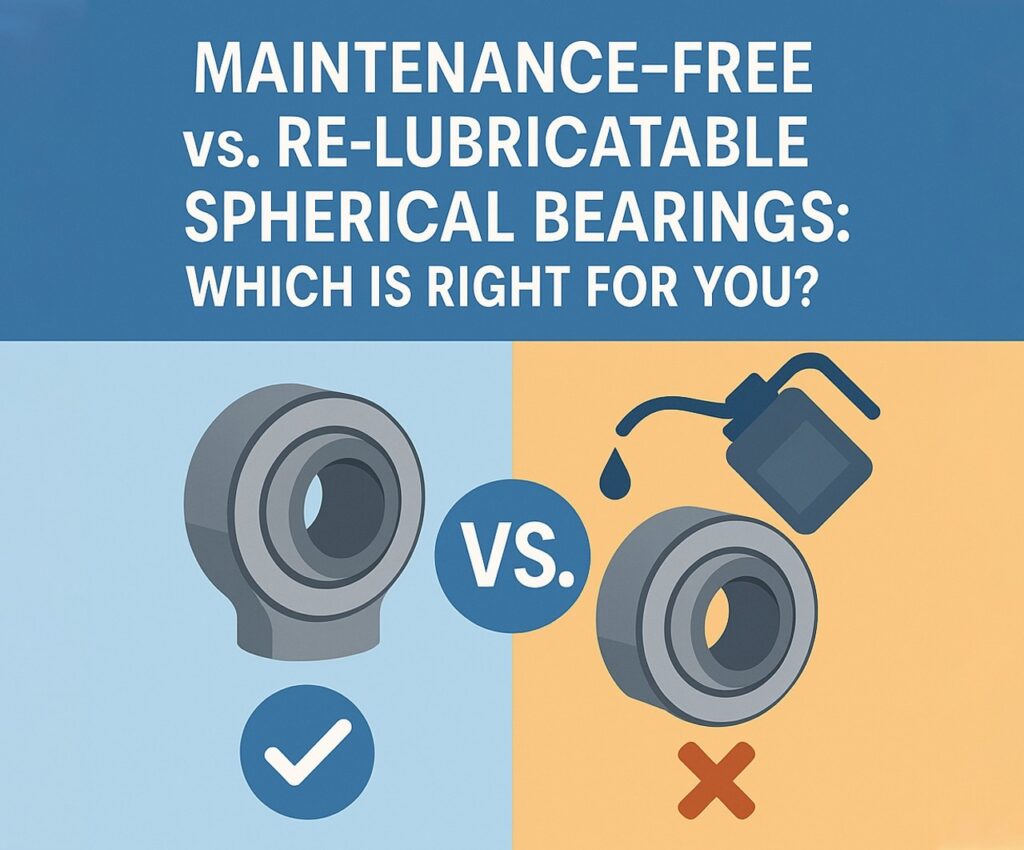Choosing between spherical ball bearing types can be more than a technical decision—it can impact your bottom line, your equipment’s reliability, and your team’s workload. Whether you’re sourcing from top spherical bearing manufacturers or comparing materials like stainless steel spherical bearings, the choice between maintenance-free and re-lubricatable options is a key point of consideration.
So, how do you make the right choice? Let’s break it down with a fresh lens on performance, cost, application suitability, and long-term value. Know More
Understanding the Basics
A spherical ball bearing allows for angular misalignment, making it ideal for heavy-duty, misaligned or rotating applications. It’s commonly used in agriculture, construction, mining, and material handling. These bearings typically come in two major types: maintenance-free and re-lubricatable.
Maintenance-free spherical ball bearing systems are engineered with self-lubricating liners or advanced materials that eliminate the need for routine greasing. On the other hand, re-lubricatable spherical ball bearing types feature a housing that allows users to periodically apply grease to reduce wear.
When Maintenance-Free Bearings Make Sense
Maintenance-free spherical ball bearing designs shine in environments where access is limited or downtime is costly. Here’s when they make the most sense:
- Remote or inaccessible machinery: If your equipment is difficult to reach, a no-maintenance design can eliminate the hassle and cost of scheduled lubrication.
- Food and beverage processing: Stainless steel spherical bearings with maintenance-free designs minimize contamination risk.
- Harsh environments: Dusty, corrosive, or wet conditions often degrade lubricants. Maintenance-free options withstand these without breaking down.
- Labor cost savings: Eliminate lubrication schedules, freeing up technicians for other high-value tasks.
With modern engineering, today’s spherical bearing manufacturers are pushing the performance of maintenance-free options, making them not just convenient but highly durable.
The Case for Re-Lubricatable Bearings
Despite the appeal of low-maintenance setups, re-lubricatable spherical ball bearing systems have advantages too:
- Heavy shock loads: Manual greasing allows for increased film thickness in high-load applications.
- Extended bearing life: Proper lubrication reduces wear and helps manage heat, leading to longer operational life.
- Detect and respond: Routine maintenance can catch early signs of failure like pitting or scoring.
- Custom lubrication: Some applications require specialty greases due to extreme temperatures or chemicals.
These bearings give operators control. In industries where failure is not an option—think aviation ground support or mining trucks—a little hands-on attention can go a long way.
Cost Considerations: Initial vs. Lifetime
Cost is often the tie-breaker in the maintenance-free vs. re-lubricatable debate. But it’s essential to think beyond the purchase price.
- Maintenance-free bearings generally cost more upfront. However, they can save on labor and downtime, especially when used in difficult-to-access locations.
- Re-lubricatable bearings are often cheaper initially. But recurring lubrication costs, labor, and potential downtime need to be factored into total cost of ownership.
If you’re buying in bulk from spherical bearing manufacturers, your price break on one type might influence your decision, but always balance it with long-term operational needs.
Performance in Real-World Applications
Here are some real-world examples showing how each type of spherical ball bearing performs:
- Wind turbines: Remote locations and high elevation make maintenance-free the go-to choice.
- Steel mills: High loads and extreme temperatures favor re-lubricatable stainless steel spherical bearings that can handle heat better with specialty lubricants.
- Automated factories: Maintenance-free bearings reduce the need for stoppages, keeping productivity high.
- Agricultural equipment: A mix of both types is often used depending on location and accessibility on the machine.
The best spherical bearing manufacturers often provide guidance based on your specific industry and environment.
Sustainability: A Hidden Angle
One growing factor in the maintenance-free vs. re-lubricatable debate is environmental impact.
- Maintenance-free spherical ball bearing systems reduce grease usage, which can be a win for sustainability goals.
- Fewer service intervals mean fewer trips, lower fuel use, and less environmental impact from maintenance crews.
On the flip side:
- Re-lubricatable bearings can be recycled more easily and don’t rely on specialized liner materials, which may be harder to process.
- But grease disposal and excess lubricant waste can be an environmental concern.
For organizations with ESG targets, this is more than a side issue—it’s a strategic factor.
Making the Final Call: Questions to Ask
When deciding between the two, ask yourself the following:
- Can my team reliably maintain these components? If not, go maintenance-free.
- Is failure catastrophic or just inconvenient? If catastrophic, manual lubrication might be worth it.
- Are we trying to lower environmental impact? Maintenance-free could align better.
- Is uptime critical? The less attention needed, the better.
- How do my top spherical bearing manufacturers recommend using each type? Their expertise can save you costly missteps.
Innovation on the Horizon
The gap between these two types of spherical ball bearing is closing. Hybrid designs are emerging, allowing occasional greasing while still reducing maintenance needs. Meanwhile, stainless steel spherical bearings with nano-coatings and intelligent monitoring systems are bringing a tech-driven edge to what was once a simple mechanical part.
Top spherical bearing manufacturers are also investing in data analytics and predictive maintenance integration, turning bearings into smart components that notify you before a failure ever happens.
Final Thoughts
There’s no universal answer when it comes to choosing between maintenance-free and re-lubricatable spherical ball bearing systems. The best choice depends on your unique application, maintenance capabilities, cost considerations, and sustainability goals.
Just remember: it’s not just about rolling elements and grease. It’s about how the right decision here enables your equipment, your team, and your bottom line to keep moving forward.
So before you place that order with your preferred spherical bearing manufacturers, weigh your options carefully. Your bearings might be small, but they play a big role in your operation’s success.

